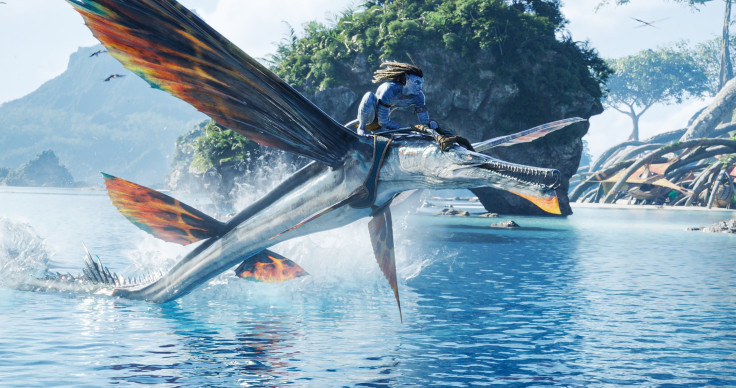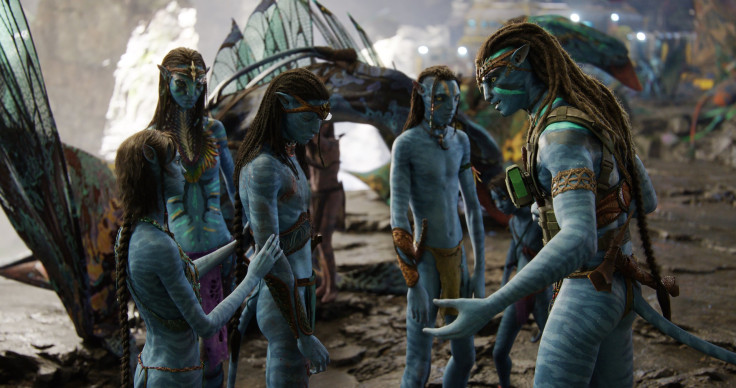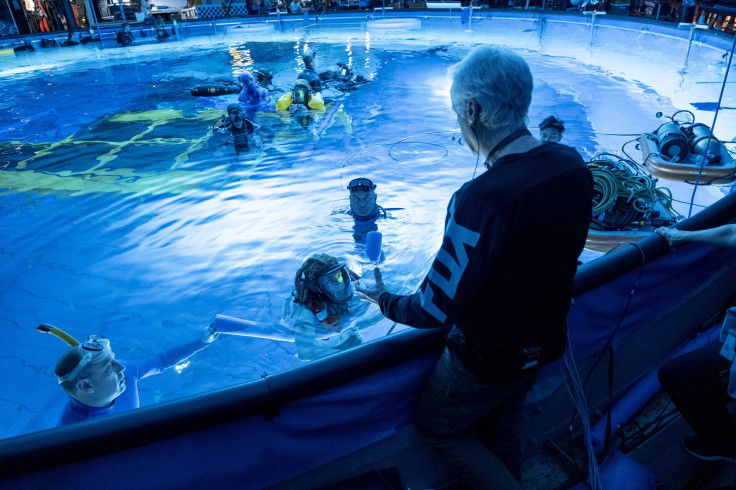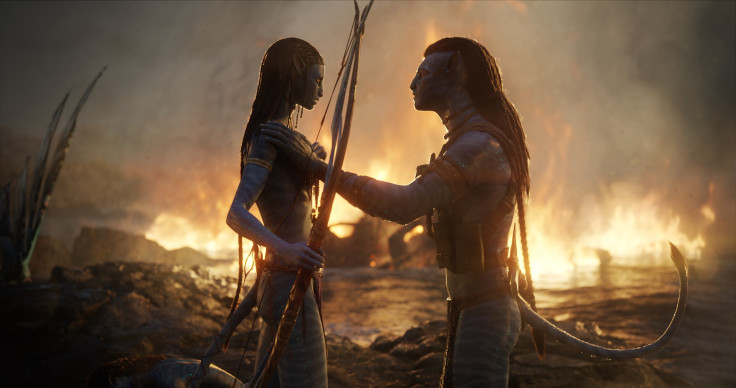
*Spoiler-warning
James Cameron's Avatar 2 finds viewers back in the ever-expanding and enchanting world of Pandora. Avatar: The Way of Water, the long awaited sequel to Cameron’s Avatar - the highest grossing film of all time - was ultimately mesmerizing and a mind-blowing immersive visual experience taking audiences on a epic adventure unlike anything seen before. From a screenplay written by Cameron, Rick Jaffa and Amanda Silver; the film’s producers Cameron and Jon Landau take to the seas with this incredible underwater adventure exploring new biomes and cultures in the vast landscapes of Pandora.
The second installment comes thirteen years after Academy Award®-winner James Cameron’s original hit the big screen wowwing moviegoers with his innovative and breathtaking epic “Avatar.” The visionary director once again invites audiences on a brand new cinematic journey with The Way of Water. The sequel, already a Golden Globe best motion-picture nominee, is surprisingly just as good if not better than its predecessor. It was so much more than just a movie, but an overall immersive experience. Known for its groundbreaking cinematic visuals and use of special effects, and 3D, High Frame Rate/ IMAX technology, Avatar continues to be a worldwide phenomenon for cinema. This time with a focus on underwater-performance capture, something that had never been done before.
Oscar winning-producer Jon Landau who has previously worked with Cameron on Titanic and the first Avatar film, plan to keep the Avatar franchise going for years to come. According to production - with over 1,500 pages of notes, Cameron and Landau realized that there was so much more than just one story to tell. So they brought together an elite group of top Hollywood screenwriters to transform Cameron's story notes into the four films that would continue the adventures of Jake, Neytiri, and their new family. The subsequent movies are all “wildly ambitious yet all anchored around one central theme: the importance of family.”
The sequel picks up ten years after the first film and undoubtedly centers on the significance of family. Jake Sully, former marine and paraplegic human is now a full-fledged Na'vi fully inhabiting his Avatar body, and leading the Na'vi Omatikaya forest clan. Sam Worthington (Jake Sully) and Zoe Saldaña (Neytiri) reprise their iconic roles as they now have formed a family, the loving parents do everything they can to keep their family safe and together as a recurring threat reappears uprooting the Sully’s. Family - a theme central to the franchise is prevalent throughout the entire film especially with the heavy focus on the children. The cast was fantastic and the kids were the highlight of the movie. They had such great chemistry and unique characteristics that made them feel familial.

They have two sons Neteyam (Jamie Flatters) and Lo'ak (Britain Dalton)—and a daughter named Tuk (Trinity Jo-Li Bliss). They are also the guardians of Kiri (Sigourney Weaver), the offspring of Weaver's character from the first film, raising her as one of their own. Some viewers found it rather peculiar making a young Weaver instead of casting a fresh face, but it was probably a way to keep her more involved in the project. However, the group of talented young actors really get to shine as the kids are at the forefront most of the film. The film spends a lot of time introducing viewers to the kids, their relationships and experiences navigating the new world.
“Family is our fortress,” Jake often reminds his wife Neytiri and their children. The kids often hang out with Spider (Jack Champion), a human child orphaned by the war and too small at the time to return to Earth, who is later revealed to be the son of human Colonel Miles Quaritch. We’ll get more into the Spider arc in a bit. In addition to Worthington and Saldaña, the film also stars Academy Award® nominee Sigourney Weaver, Stephen Lang, Cliff Curtis and Academy Award® winner Kate Winslet.
After a decade of living in bliss, a former threat resurfaces with the return of “The Sky People,” forcing the happy family to leave their home and explore further regions of Pandora. The film sees the return of the villainous Colonel Miles Quaritch (Stephen Lang), only he is now an avatar Na'vi version who has come to finish what he started. The menacing colonel is back for vengeance and is on the hunt for Jake who is responsible for the death of his human form.
He brings along an elite team of former-human-now-Na'vi soldiers who are the film's main antagonists, the soldiers are resurrected as recombinants (recoms) - autonomous avatars embedded with the memories of the humans whose DNA was used to create them. Ironically, The recoms are back as the faces of their enemies. However, they are much bigger, meaner and dangerous. Although, it was quite unclear why the soldiers are so hell-bent on hunting down the Sully family - other than the plot needing a super villain, Lang does play a mad man fairly well.
Jake faces the ultimatum of deciding whether to run and hide or fight back against the oppressor. Conclusively, The Sully's travel across the vast planes of Pandora as Jake takes his family into hiding into the harmonious underwater region run by Tonowari (Cliff Curtis), the leader of a clan called the Metkayina. In this new unfamiliar environment the Sullys must learn to navigate both the dangerous water world and the uncomfortable dynamics of gaining acceptance from their new community.

As mentioned, The film really centered on the importance of family and protecting your loved ones as Tonowari - who is also a leader and a family man himself must consider the dangers of letting in outsiders into their home. Alongside his wife Ronal (Kate Winslet), Tonowari is worried about the potential dangers that the new Na'vi visitors could bring them, but also he can't turn them away. Jake reminds the clan leader of - Uturu, a Na’vi tradition stating that any refugee seeking sanctuary must be granted safe harbor. Although the Metkayina leaders both gave a solid performance, some can find Winslet's portrayal of an indigenous spiritual leader fairly tone-deaf.
Aside from the military antagonist, there is also the Resources Development Administration (RDA). “The Sky People” have returned to Pandora to not only run a mining operation to strip the moon of the valuable mineral known as “unobtainium, ” but the (RDA) returns with the added objective to colonize the entire moon and make it the new home for humanity, as Earth is on the precipice of no longer being inhabitable. Go figure.
The franchise once again casts the military, and planet-destroying humans as its biggest antagonists, although the villains' motives are sometimes a bit unclear as previously mentioned. After reducing a native forest to a wasteland of burning lumber, the RDA’s base of operations has made the forest its new home, a sprawling city called Bridgehead. The once beautiful landscape is now over run by rigs, military vehicles, machinery, weapons, AMP suits and Sky people that are packing a massive array of weapons with only one goal in mind: utter domination. The heavily armed fleet has replaced the habitation modules that once held scientists for the avatar program. Now they carry military equipment and machinery destroying everything in sight.
In addition to the aircraft fleet, the RDA has a monstrous aerodynamic 400-feet long ship, SEA DRAGON. The Sea Dragon carries within it, smaller vessels, all designed to assist in the hunting of the beautiful intelligent whale-like creatures tulkun, and for defense purposes. The Tulkun were the real scene-stealers and highlight of The Way of Water, as it was hard to watch the fictional creatures be hunted. The majestic and powerful creatures are highly intelligent, emotional and spiritual, they also bond with the Metkayina reef people. The attack on these beautiful creatures emphasizes that humans are the real enemy.
Cameron continues to play with the concepts of morality, responsibility and environmentalism when faced with the recurring powerful human evil - “Sky People.” Not only did humans destroy their own planet, but the alien poachers and soldiers now dare to hunt the sacred water animals and attack the tranquil non-violent habitat of Pandora. The brutal and long hunting scenes are so tragic to watch that viewers almost forget that none of this is real. Viewers were so enamored with the beautiful avatars, creatures, environments and wonders that it beholds. Cameron made the decision to keep the story set on Pandora, to explore new biomes and new cultures, and show audiences how it could contain a range of landscapes—just like Earth. “Based on his love for the oceans, my love for the oceans, we settled on the oceans as the next sounding ground for our stories” says Landau.

The film really focused heavily on the unique aesthetics differentiating the diverse tribes and different cultures. Cameron proves he pays attention to the little details in his dynamic world-building reminding you why these films are so important for storytelling. Little details such as the different clans physical features like the Metkayina having fins and larger tails built for swimming and fishing is a perfect example of how much these films mean to Cameron.
“With the story in place, Cameron and Landau challenged the film’s key department heads to come up with methodologies and new technologies that would allow Cameron to both create even more expressive and engaging characters on the screen, and to set them in a world that, despite its fantastical design, would come off as real. The result was that as production began Cameron had at his disposal a completely new suite of technology tools. “The stuff we’re working with now is so advanced compared to the first film,” Cameron says. “Now does that make a better movie from an audience perspective? Absolutely not. The broader audience only cares about a story, the characters, and how the film makes them feel. I keep that in mind first and foremost every single day.”
Landau says. “We want to push the boundaries of storytelling and captivating audiences. All that does is make us work harder.”
Return to Pandora with us. #AvatarTheWayOfWater only in theaters December 16th. pic.twitter.com/1eS8y6b8DD
— James Cameron (@JimCameron) December 6, 2022
For “Avatar: The Way of Water,” Cameron and his team had to really study, research and experiment to determine how they would capture performances under water, something that had never been done before. “The key to it was to actually shoot underwater and at the surface of the water so people were swimming properly, getting out of the water properly, diving in properly,” Cameron says. “It looks real because the motion was real. And the emotion was real.” According to Production, the behind-the-scenes team constructed a gigantic tank at the Manhattan Beach Studios (Cameron and Landau’s production company, Lightstorm) that was sufficient to hold enough water to allow Cameron to replicate real-world oceanic conditions. Standing 120 feet long, 60 feet wide and 30 feet deep and holding more than 250,000 gallons of water, the massive tank functioned as the films’ underwater “Volume,” as performance-capture stages are known.
"Creating a live-action film that transformed motion capture into performance capture and pushed visual effects technology to a new and astonishing frontier. Yet, at every turn, Cameron took care to ensure that the revolutionary technology invented for the movie never overwhelmed the performances and emotion of the characters or the sweep of the story."

As expected, Cameron invites audiences into this fully imagined world full of striking visuals and phenomenally rendered action-packed sequences that does universally overshadow the story a bit. While it can be argued the Avatar films are known more for their dynamic cinematography over actual storytelling - the sequel really does expand upon the universe in ways that the first film didn’t. The world of "Avatar" feels much larger this time around. Not only did we get more world-building but we were introduced to new worlds within - that can only help to intrigue viewers of the grander possibilities. From new environments, to new alliances, and even possible villains.
The sequel really focuses on Jakes children especially when Jake's boys learn the ways of the water clan. We also saw the arc of a new character named Spider (Jack Champion)— who started off as an ally. He seems to be attached to his newly discovered blood-related father Colonel Miles Quaritch, who he surprisingly saves at the end of the movie. This could potentially be a set-up for future films. With the Sullys not aware of Jacks treacherous rescue, the subsequent storyline is made richer by creating an expansive web of narratives. While viewers could argue that there needed to be a much stronger protagonist/antagonist line with both Jake and Quaritch unusually out of picture for long extended periods, I would argue that this was intentional. In the grander scheme of things this may be an on-going battle. Although, a little more Zoe butt-kicking would’ve been nice as she sends shivers down enemies backs with her archery skills.

Overall the simple and familiar story still felt more cohesive than the first film and will most definitely get audiences excited for what’s to follow. The jaw-dropping sequel was bigger, better and more emotional. With superhero movies dominating the box-office in the last decade, viewers can’t forget the cultural impact of “Avatar” and the sense of wonder it instills in movie-goers. The astonishing and immersive film was action-packed, thought provoking, and a wildly entertaining experience. The generational family epic not only explores morality and responsibility, but is also a direct message about colonization, exploration, environmentalism and preservation. "Avatar: The Way of Water" is without a doubt a James Cameron blockbuster, that can only be made by him and his vision.
While the movie could've been a bit shorter, it was a great sequel that viewers must see in theaters for the full cinematic immersive experience. Grab your popcorn but don’t drink too much as the film's runtime is 3 hours 12 minutes.
The motion picture event of a generation is finally here.
— Avatar (@officialavatar) December 16, 2022
Experience #AvatarTheWayOfWater now playing only in theaters. Get tickets: https://t.co/9NiFEIHBie pic.twitter.com/q0BpawCpOp
© 2025 Latin Times. All rights reserved. Do not reproduce without permission.



